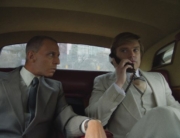Benoît Jacquot’s Farewell, My Queen, like his breakthrough film, 1995’s A Single Girl, sees events almost exclusively through the eyes of his teenage female protagonist. Unlike the earlier film—which helped made an international star of Virginie Ledoyen—Queen is a distaff costume drama with little insights or fresh observations on a familiar subject, the last days of Marie Antoinette as the queen of France.
However, his film is certainly pleasing to the eye, filmed on location at Versailles. Yet the young Sidonie, a quiet, dutiful handmaiden who has become one of Marie’s favorites, is so colorless as to be a blank slate, severely hampering the movie’s attempt to absorbingly chronicle the chaos that accompanies the storming of the Bastille and its aftermath. That Sidonie’s personal history is never developed leaves her fatally one-dimensional. Is she from a common family? How did she attain such a coveted position?
The film begins on that fateful date, July 14, 1789. One of its facile ironies has Sidonie awoken in her sparsely furnished room by the gilded clock on her dresser, a gift from the queen that
is soon taken by another, covetous young lady in waiting. As Sidonie leaves the servants’ tawdry quarters for her appointment with Marie Antoinette, the other woman taunts and frightens the naive Sidonie by holding up a dead rat by its tail. Later, Sidonie, while floating in a gondola on a lake outside the palace, sees another dead rat, this one floating in the water. If we didn’t get it the first time, Jacquot screams, “The monarchy is collapsing!”
The bulk of the film dramatizes the Queen’s fascination with her closest friend, Gabrielle de Polignac. Intimations that she and her personal favorite are lesbian lovers are historically speculative at best, but the overly emotional on-screen response by the queen when Gabrielle is not present at court is certainly in keeping with Marie Antoinette’s neediness. It’s too bad that Jacquot’s earlier muse, Virginie Ledoyen, has so little to do as Gabrielle, aside from looking sensational in various gowns and even more so in a gratuitous—but welcome—nude scene, where Sidonie, sent by the Queen to fetch her favorite, momentarily looks over the sleeping naked woman, whom she thinks of as a rival for the queen’s affections. That Jacquot never makes Sidonie’s own feelings for the queen clear—does she really have affection for her, is it simply infatuation, or does she merely enjoy being near such a formidable woman?—undercuts what could have been a powerful display of jealousy or, at the very least, understanding Gabrielle’s power over the queen.
Trotting familiar ground, Jacquot at least doesn’t revert to the insipidness of Sofia Coppola’s Marie Antoinette. His Marie, played by Diane Kruger—who resembles the earlier movie’s Kirsten Dunst, particularly in profile—retains her dignity even while exhibiting the clichéd (and possibly historically inaccurate) shallowness of a woman who prefers costume balls to literature and the arts. But the movie remains mainly decorative, with the sets, costumes and Romain Winding’s exquisite photography outdueling the drama. (Other châteaux besides Versailles were used as locations.)
To be charitable, let’s call this a variation on Rosencrantz and Guildenstern Are Dead, Tom Stoppard’s classic play that retold Hamlet through its minor characters. But aside from not having Stoppard’s cleverness, Jacquot’s film consists of little more than servants improbably eavesdropping on privileged conversations among the monarchs. While certainly possible, since so many of the servants had access to the secret rooms where so many power plays occurred, they smack of little more than contrivances that help propel what little narrative there is forward.
Léa Seydoux—best known for her small but pivotal roles in Midnight in Paris and Mission: Impossible–Ghost Protocol—is hampered by a part that’s mostly reactive. Only at the very end, when the queen orders Sidonie to undertake a special undercover mission, does she become convincingly alive. But even here, Sidonie’s transformation from vaguely formed teenager to assured young woman is a quicksilver change that is less plausible psychologically.





